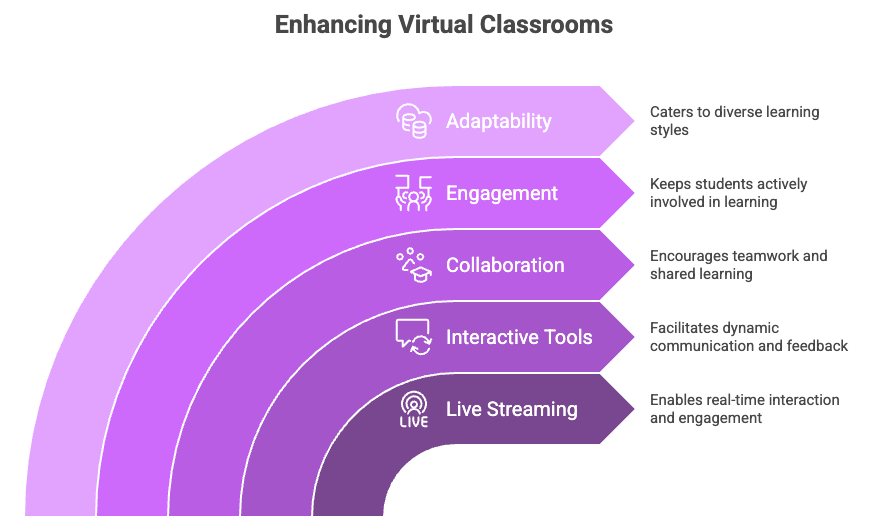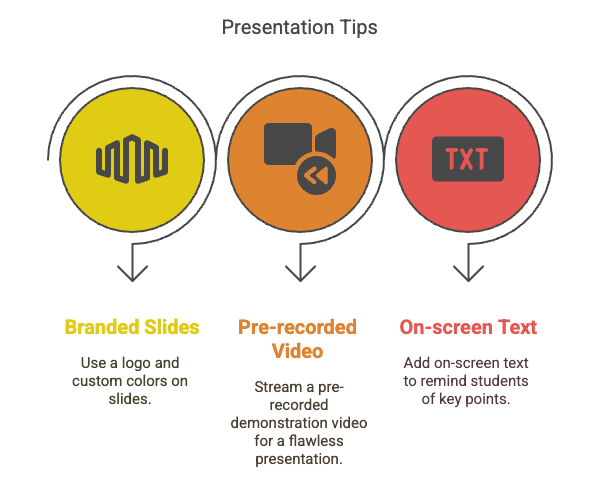Future of Virtual Classrooms: Lessons from Live Tech
Explore how live streaming helps shape the next wave of virtual classrooms. See how online tools bring people together for real-time learning and growth.

In a world full of automation, the demand for a paper writer with no ai by WritePaperForMe reflects a growing desire for human-authored content. This concern ties directly into education, especially as virtual classrooms become more common. With schools shifting to online formats, instructors have worked hard to keep students engaged. Live streaming has played a key role in making digital learning more dynamic and personal.
Live content lets students see demonstrations in real time. Classrooms across various grades have found ways to engage learners, and this shift has highlighted the need for a digital classroom that goes beyond simple file-sharing. Instead, it allows for actual interactions. This is where a dedicated live streaming platform like LiveReacting becomes essential, transforming a one-way broadcast into a two-way street of communication with tools like text-based chats and instant polls.
When describing what a virtual classroom is, one must include collaboration. Educators learned to answer questions on the spot, clear up confusion, and watch for nonverbal feedback. Virtual class setups, powered by robust software, showed a bright path for modern education. When describing what a virtual classroom is, one must include collaboration. Educators learned to answer questions on the spot, clear up confusion, and watch for nonverbal feedback. Virtual class setups, powered by robust software and tools like an AI tutor, showed a bright path for modern education.
Virtual classrooms have sparked interest far and wide. Some ask, “What is a virtual classroom and how does it differ from a standard class?” The best answer centers on engagement. Learners join sessions through a live video link, but they still see and hear one another. This environment strives to keep people active, not silent, and tools designed for interaction are key.
Each digital classroom thrives when teachers plan lessons that suit remote learning. For instance, educators can break content into short segments. They can host breakout rooms, so groups can work on tasks together. This approach, which aims to mimic the social nature of an in-person space, is powerfully supplemented by technology.
People often forget that online schooling needs to address different learning styles. Some prefer visuals or short quizzes, while others want group discussions or games. A virtual class using LiveReacting can adapt: it can offer dynamic chat boxes, live polls to gauge understanding, or even interactive games like trivia to spark creativity. The ultimate goal is to help learners grow in skill and knowledge, without losing that sense of connection.
Live streaming technology sparked the rise of virtual classes. Initially used for entertainment, it evolved into a tool that bridges distances and makes remote lessons interesting. A key benefit of live streaming is immediate communication. With LiveReacting, students can type questions in a real-time chat that appears on-screen, and teachers can respond right away. This helps classes flow naturally, rather than feeling like a stale recording.
Another plus is that live streaming can be paired with other interactive elements. Instead of a one-way lecture, sessions take on a dynamic feeling. With LiveReacting, educators can integrate:
- Live Polls and Quizzes to check for understanding.
- Word Clouds to brainstorm ideas collectively.
- On-screen comments to highlight great questions. This transforms virtual classroom training into an active endeavor for everyone involved.

The adoption of virtual classroom training came with certain hurdles. Early attempts often felt like experiments that lacked the heart of face-to-face networking. As teachers discovered the potential of a digital classroom, they realized they needed to adapt techniques, not just replicate them. For instance, instructors had to share more concise lessons. Remote learners often lose concentration if a lecture goes on too long. A quick, 2-minute LiveReacting poll can serve as a perfect "brain break" and refocus attention.
Moreover, technical issues once caused frustration. Poor internet connections, muffled audio, and complicated software were common. Platforms like LiveReacting solve this by being cloud-based and intuitive. There's no software to download, and it seamlessly integrates with popular platforms like Facebook, YouTube, and Twitch. This stability allows educators to anticipate hiccups and focus on teaching, not troubleshooting.
Virtual class meaning can vary, but the modern definition leans toward two-way communication. It’s not just about passively viewing material; it’s about active engagement. To achieve that, teachers started to borrow ideas from popular live streamers. They introduced “live Q&A” segments, a feature easily managed within LiveReacting's studio. They also tested fun rewards, like digital badges or shout-outs for students who win a live quiz. These playful touches boost the sense of belonging.
At its core, a virtual classroom must remain easy to access. LiveReacting ensures this by allowing instructors to pre-schedule streams and share a single link with students. With our studio, you can prepare all your interactive elements and graphics beforehand, so when it's time to go live, everything works with a single click.
Instructors often wonder how to keep up the energy when teaching online. One technique is to maintain a friendly, natural tone. Another is to use tools that raise the bar for the digital experience. With LiveReacting, a teacher can:
- Share professionally branded slides with a logo and custom colors.
- Stream a pre-recorded demonstration video within the live session for a flawless presentation.
- Add on-screen text or tickers to remind students of key points or upcoming assignments.

This approach brings new life to the content and is highly effective for step-by-step projects and technical subjects that benefit from direct illustration.
The notion of what is a virtual classroom covers a lot more than fancy software, but the right tools empower the human element. In a virtual environment, teachers need to keep watch for signs of confusion. Using a LiveReacting poll with options like "I'm following along" or "Please explain again" provides instant, anonymous feedback. This fosters an atmosphere of respect and trust, as even shy students can participate without fear.
In virtual classroom training, nurturing a personal connection is vital. To address this, many schools schedule online social events. Imagine hosting a school-wide trivia night or a fun game show: both are easy to set up with LiveReacting's gaming templates. These events help students feel like more than just a block of squares on a screen.
Thinking about the future, it’s clear that virtual classrooms will continue to rise in popularity. Live streaming technology will keep evolving, offering even more interactive features. LiveReacting is at the forefront of this movement, continuously developing new ways to make online learning more engaging and effective.
However, the human element remains the most critical factor. Every digital classroom demands thoughtful planning and genuine interest from instructors. The goal of our platform is to handle the technical complexities so educators can focus on what they do best: teaching. In the end, a virtual class stands for inclusivity, creativity, and consistency. As technology moves forward, LiveReacting will be there to help shape the ways in which humans grow and learn.
Transform Your Live Streams with LiveReacting
Join 10,000+ streamers who are boosting engagement and viewership by adding pre-recorded videos, games, polls, and countdowns to their streams.
Try LiveReacting for free today and take your streams to the next level!
